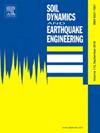近断层山区风力涡轮机在物理模拟地震地面运动下的性能评估
IF 4.2
2区 工程技术
Q1 ENGINEERING, GEOLOGICAL
引用次数: 0
摘要
近几十年来,风力涡轮机(WTs)经历了前所未有的增长,它们在山区的安装增加大大增加了相关的地震风险。然而,对地震波传播和地震动衰减的理解仍然有限,特别是考虑到震源-路径-场地效应,这成为地震隧道抗震设计的关键瓶颈。为了解决这一问题,本文通过分析震源特征、波传播路径和当地场地条件的综合影响来评估WTs的抗震性能,并提出了一种基于场景地震模拟的山区WTs场地效应评估新方法。在方法上,采用频波数(FK)法求解深部地壳格林函数的半解析解,采用谱元(SE)法进行高效的大尺度波场模拟,采用有限元(FE)法对WT响应进行详细的结构建模。由此产生的FK-SE-FE方法可以实现从断层破裂到结构响应的全过程物理模拟。以鸡石山MS6.2地震为例,综合近断层地震动,评价山地地形对WTs地震响应的影响。结果表明,在地震波传播过程中,山的存在显著增加了结构的整体地震响应,山顶WT的塔顶位移比山底放大了2.56倍。此外,连续脊效应导致山脚下的峰值地面加速度增加,但整体放大效应在山顶更为明显。这些发现为加强复杂地形中WTs的抗震设计规范和制定风险缓解策略提供了有价值的见解。本文章由计算机程序翻译,如有差异,请以英文原文为准。
Performance assessment of wind turbines in near-fault mountain regions subjected to physics-based simulated earthquake ground motions
In recent decades, wind turbines (WTs) have experienced unprecedented growth, and their increased installations in mountainous regions has significantly elevated the associated seismic risk. However, the understanding of seismic wave propagation and ground motion attenuations, particularly considering source-path-site effects, remains limited, becoming a key bottleneck in the seismic design of WTs. To address this, this paper assesses the seismic performance of WTs by analyzing the combined effects of seismic source characteristics, wave propagation paths, and local site conditions, and proposes a novel method for assess site effects on WTs in mountainous regions using scenario-based earthquake simulations. In the methodology, the frequency-wavenumber (FK) method is employed for the semi-analytical solution of deep crustal Green's functions, the spectral element (SE) method for efficient large-scale wave field simulations, and the finite element (FE) method for detailed structural modeling of WT responses. The resulting FK-SE-FE approach enables a full-process physics-based simulation from fault rupture to the structural response. Using the Jishishan MS6.2 earthquake as a case study, near-fault ground motions are synthesized to evaluate the influence of mountainous' terrain on the seismic response of WTs. Results indicate that the presence of the mountain during seismic wave propagation significantly increased the overall seismic response of the structure, with the tower-top displacement of the mountain-top WT being amplified by up to 2.56 times compared to the mountain base. Additionally, the continuous ridge effect led to an increased peak ground acceleration at the mountain base, but the overall amplification effect is more pronounced at the mountain top. These findings provide valuable insights for enhancing seismic design codes and developing risk mitigation strategies for WTs in complex terrains.
求助全文
通过发布文献求助,成功后即可免费获取论文全文。
去求助
来源期刊

Soil Dynamics and Earthquake Engineering
工程技术-地球科学综合
CiteScore
7.50
自引率
15.00%
发文量
446
审稿时长
8 months
期刊介绍:
The journal aims to encourage and enhance the role of mechanics and other disciplines as they relate to earthquake engineering by providing opportunities for the publication of the work of applied mathematicians, engineers and other applied scientists involved in solving problems closely related to the field of earthquake engineering and geotechnical earthquake engineering.
Emphasis is placed on new concepts and techniques, but case histories will also be published if they enhance the presentation and understanding of new technical concepts.
 求助内容:
求助内容: 应助结果提醒方式:
应助结果提醒方式:


